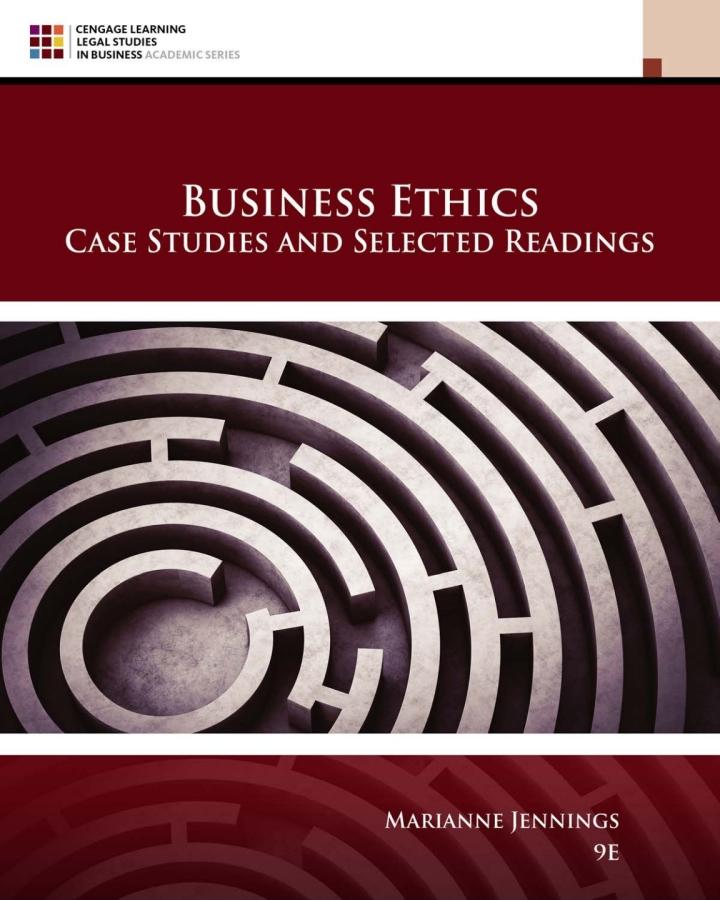Stakeholder theory is unique because it crosses over so many areas of business: the fields of business
Question:
Stakeholder theory is unique because it crosses over so many areas of business: the fields of business ethics, management and corporation law have all focused on stakeholder theory. While there is one name, stakeholder theory is used in different ways in these silos of business.
Proponents of the stakeholder theory believe that employees, creditors, suppliers, customers, and communities, in addition to shareholders, all contribute to the success of the corporation, and that the company directors, therefore, have responsibilities to all of these constituencies. \(^{3}\)
Stakeholder theory dates back to the 1930s when the idea of the central state was prominent in political theory, debate, and legislation, and the existence of self-governing corporations was seen as something that could undermine the utilitarian view that all entities should function for the good of the whole. \({ }^{4}\) However, very little was done with the notion of corporations' responsibility to society until, citing the efforts of the 1930s scholars, the work of Edward Freeman on strategic management emerged in the 1980s. \({ }^{5}\) With Freeman's work, stakeholder theory not only became a basis for business strategy, but it also became a foundation for corporate governance. \({ }^{6}\) In addition, the use of stakeholder theory as a utilitarian tool reemerged in the new scholarship.
There are three basic issues in stakeholder theory: (1) Who is a stakeholder? (2) What is the responsibility of a business to those stakeholders? and (3) Does consideration of stakeholder interests benefit society and shareholders?
The definitions' variations are in wording, "group" versus "coalition" versus "organization" and role, "stake in consequences" versus "opposition to be negated." Perhaps an easier way to understand who stakeholders are is through an example. The Yucca Mountain Nuclear Waste Repository was first proposed for construction in 1987 as a place for storing spent nuclear fuel rods from the nuclear plants (about 120 of them, at that time) in the United States. The corporations that operated the plants needed a permanent place for disposition of the fuel rods, and the federal government had authorized the use of Yucca Mountain, land located in Nevada, for the construction of such a repository. Stakeholders include those who live near the site in Nevada. Other stakeholders include those who were concerned about the possible effect of the spent-rod storage on underground water sources, which included ranchers, farmers, and others who drew from underground water tables. We can discover stakeholders by going up and down the supply chain in many situations. The employees at nuclear plants are affected by whether the repository is built because of the safety issues with temporary storage of spent rods at their sites. Without permanent storage for the spent fuel, the plants would need to cease operations. Without the plants operating, those living in the states and regions surrounding the plants would be affected because nuclear plants are baseload plants and provide the electricity needs for homes, businesses, and factories. Without electricity, business and factory operations halt, and the jobs of those employed there are at risk. Companies that build nuclear plants, manufacturers of fuel for the plants, and vendors that sell everything from tools to paper supplies to nuclear plants are also affected. Looking at issues through stakeholder theory gives us a picture of an interconnected web. That is, the decisions of a corporation or any business are never made in isolation-there is a web of interconnection that we have through our actions, as depicted in Figure 3.1.
Regardless of the decision made on the nuclear repository, other companies, customers, communities, and future generations will be affected. Stakeholder theory asks that organizations consider the stakeholders in making their decisions about their actions. The first step, then, in applying stakeholder theory is to identify stakeholders........................
Discussion Questions 1. Give examples of stakeholders and what interests they might have in a company's decisions.
2. Does Milton Friedman see any benefit in considering the interests of employees as a company makes decisions?
3. Explain the web of stakeholders and how the impact of one decision affects others in the web.
Step by Step Answer:

Business Ethics Case Studies And Selected Readings
ISBN: 9780357453865
9th Edition
Authors: Marianne M. Jennings





